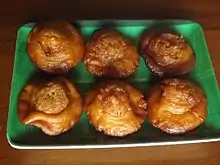 Konda Kavum | |
| Type | Sweet |
|---|---|
| Course | Dessert |
| Place of origin | Sri Lanka |
| Main ingredients | Rice flour, Treacle |
Kevum or Kavum (Sinhala: කැවුම්) is a deep-fried Sri Lankan sweet made from rice flour and kithul (sugar-palm) treacle, with a number of variants adding additional ingredients. It is also known as oil cake. Kevum is traditionally given and consumed during celebrations of Sinhala and Tamil New Year.[1]
History
Kevum is mentioned in ancient Sri Lankan texts including the Ummagga Jatakaya, Saddharma Ratnawaliya and Pujawaliya.[1]
Varieties
The Dhathuwansaya, an ancient Sinhala text, mentions 18 kinds of kevum including Sedhi Kevum, Mun Kevum, Ulundu Kevum, Uthupu (shaped using a coconut shell) and Ginipu (fire kevum).[2]
- Konda kevum (Sinhala: කොණ්ඩ කැවුම්) - hair kevum is the most common variant. It has a dark reddish color. The dough of rice flour and kithul treacle is flavored with salt and cardamom. Konda (Sinhala: කොණ්ඩ) is the Sinhala word for hair, and is named so as the shape of the konda kevum resembles hair tied up into a bun. It is shaped by hand and without a special mold.
- Naran kevum (Sinhala: නාරං කැවුම්) - mandarin kevum is the size and shape of a mandarin, colored yellow with saffron. Green gram flour and scraped coconut are added to the basic kevum mix of rice flour and treacle.[2]
- Thala kevum (Sinhala: තල කැවුම්) - sesame kevum has sesame in the kevum dough.
- Undu kevum (Sinhala: උඳු කැවුම්) - dal kevum is kevum flavored with urad dal.
- Mun kevum (Sinhala: මුං කැවුම්) - gram kevum adds green gram flour and saffron to the kevum mix of rice flour and treacle. The kevum are diamond shaped and yellow.
- Handi kevum (Sinhala: හැඳි කැවුම්) - spoon kevun is flavored with cumin and fennel.
References
- 1 2 "Of Kiribath, Kavum and Kokis". Daily News. 13 April 2011. Retrieved 12 April 2014.
- 1 2 Kariyawasam, Dayananda (13 April 2003). "Naran and Sedhi kavum". Sunday Times. Retrieved 13 April 2014.
External links
Wikimedia Commons has media related to Kavum.
This article is issued from Wikipedia. The text is licensed under Creative Commons - Attribution - Sharealike. Additional terms may apply for the media files.